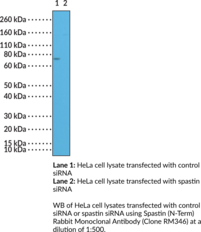Territorial Availability: Available through Bertin Technologies only in France
- Correlated keywords
- 31-1232-00 31123200 immuno chemical histochemistry immunohisto chemistry SPG-4
- Product Overview:
Spastin is an ATP-dependent microtubule-severing protein and a member of the ATPases associated with various cellular activities (AAA) family encoded by SPG4 in humans.{59696} It is composed of a hydrophobic region, microtubule-interacting and endosomal trafficking (MIT) domain, microtubule-binding domain, and an AAA ATPase domain.{59692,59693} It is ubiquitously expressed and localized to the endoplasmic reticulum. Alternative splicing of SPG4 produces a second shorter isoform that lacks the first 87 amino acids of full-length spastin and is localized to the cytosol.{59694} Spastin functions as a hexamer that binds to tubulin dimers on the plus-end of microtubules and disrupts tubulin dimer interactions in an ATP-dependent manner to sever them from microtubules.{59695} Mutations in SPG4 are associated with autosomal dominant uncomplicated hereditary spastic paraplegia (HSP).{59692,59694} Cayman’s Spastin (N-Term) Rabbit Monoclonal Antibody can be used for immunohistochemistry (IHC) and Western blot (WB) applications.
Cayman Chemical’s mission is to help make research possible by supplying scientists worldwide with the basic research tools necessary for advancing human and animal health. Our utmost commitment to healthcare researchers is to offer the highest quality products with an affordable pricing policy.
Our scientists are experts in the synthesis, purification, and characterization of biochemicals ranging from small drug-like heterocycles to complex biolipids, fatty acids, and many others. We are also highly skilled in all aspects of assay and antibody development, protein expression, crystallization, and structure determination.
Over the past thirty years, Cayman developed a deep knowledge base in lipid biochemistry, including research involving the arachidonic acid cascade, inositol phosphates, and cannabinoids. This knowledge enabled the production of reagents of exceptional quality for cancer, oxidative injury, epigenetics, neuroscience, inflammation, metabolism, and many additional lines of research.
Our organic and analytical chemists specialize in the rapid development of manufacturing processes and analytical methods to carry out clinical and commercial GMP-API production. Pre-clinical drug discovery efforts are currently underway in the areas of bone restoration and repair, muscular dystrophy, oncology, and inflammation. A separate group of Ph.D.-level scientists are dedicated to offering Hit-to-Lead Discovery and Profiling Services for epigenetic targets. Our knowledgeable chemists can be contracted to perform complete sample analysis for analytes measured by the majority of our assays. We also offer a wide range of analytical services using LC-MS/MS, HPLC, GC, and many other techniques.
Accreditations
ISO/IEC 17025:2005
ISO Guide 34:2009
Cayman is a leader in the field of emerging drugs of abuse, providing high-purity Schedule I-V Controlled Substances to federally-licensed laboratories and qualified academic research institutions for forensic analyses. We are certified by ACLASS Accreditation Services with dual accreditation to ISO/IEC 17025:2005 and ISO Guide 34:2009.





